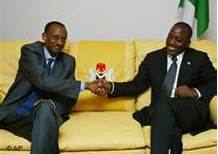
The ’94 Rwanda genocide was first and foremost an African problem in need of an African response. The intersection of complex humanitarian crisis including the presence of thousands of refugees from Rwanda who were welcomed in both Goma (North Kivu) and Bukavu (South Kivu), the internally displacement of Congolese families, the unsolved historical grievances between the different ethnic group in Rwanda, Burundi, DR Congo and Uganda, nationality, gender, sexism, power differentials, colonialism, structural and systemic violence, inequalities, class, militarization, organize crime and plundering of national resources created the opportunity for regional conflict transformation program using Intersectionality-informed approach.
Being part of the solution after being part of the Problem.
The key role played by the Church of Rwanda in orchestrating the killings of the innocent Tutsi and Hutus required that the Church of Rwanda be part of long term solution. The regional African Churches and their partners were called upon to walk alongside the Churches of Rwanda regardless of their actions. The Church of Christ in Congo (ECC) in South Kivu province invited the Mennonite Central Committee (MCC) to initiate a joint Peacebuilding Program as a means to accompany the Regional Churches. The Program first started in 96-99 and after many years of absence, MCC, in 2014, decided to return to the region to support the local organization.
Beyond the “religious actor” model: structural activism for Peace.
Using proactive and creative thinking, the Mennonite Central Committee suggested to the Church of Christ in Congo, ECC, and other stakeholders the creation of a non-church affiliated structure which was named The Council for Peace and Reconciliation (COPARE).
COPARE ( structure for activism for peace) included stakeholders (activist for peace beyond the religious actor) both women and men, from faith based organizations, civil society organizations, business organizations, government, refugees from Rwanda and Burundi, internally displaced people’s, universities, colleges and high school representatives, media, and other. The Council for Peace and Reconciliation, COPARE, demonstrated the ability to use Intersectionality- informed qualitative research methodology as it correlated to Peacebuilding program.
Positive outcome: Lessons Learned and best practices
Stakeholders interacted, trusted and learned from each other how race, ethnicity, class, gender, age, disability and ability, nationality, citizenship, religion, create (social conflict) different experiences that can or not contribute to building Peace. They learned from each other the transformative experiences that occurred when different statuses meet.
To a final account COPARE continues to be a viable Peacebuilding institution.
About the author
— Fidele A Lumeya is the Director of Strategy and Operations
Director en charge de la planification Strategique et Operationnelle
Congolese American Council for Peace and Development.
www.cacpdusa.org
Flumeya@gmail.com
240-281-8577
“I cannot change the past but I offer to work for a better future through Development Peace and Justice”.
